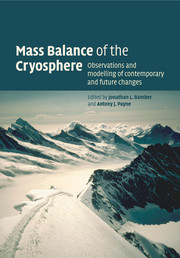Book contents
- Frontmatter
- Contents
- List of contributors
- Foreword
- Preface
- 1 Introduction and background
- Part I Observational techniques and methods
- Part II Modelling techniques and methods
- Part III The mass balance of sea ice
- Part IV The mass balance of the ice sheets
- 10 Greenland: recent mass balance observations
- 11 Greenland: modelling
- 12 Mass balance of the Antarctic ice sheet: observational aspects
- 13 Antarctica: modelling
- Part V The mass balance of ice caps and glaciers
- Index
- References
11 - Greenland: modelling
Published online by Cambridge University Press: 16 October 2009
- Frontmatter
- Contents
- List of contributors
- Foreword
- Preface
- 1 Introduction and background
- Part I Observational techniques and methods
- Part II Modelling techniques and methods
- Part III The mass balance of sea ice
- Part IV The mass balance of the ice sheets
- 10 Greenland: recent mass balance observations
- 11 Greenland: modelling
- 12 Mass balance of the Antarctic ice sheet: observational aspects
- 13 Antarctica: modelling
- Part V The mass balance of ice caps and glaciers
- Index
- References
Summary
Introduction
Modelling the mass balance of the Greenland ice sheet is a way to improve our understanding of the processes that are important for the behaviour of the ice sheet. Models are tools to find out whether we can explain the observations and extrapolate them to areas for which no observations are available. The purpose of mass balance models is to relate mass balance to the prevailing or changing climate. This offers the possibility to predict how the ice sheet responds to climatic change. Changes in the ice flow have response times of the order of 104 years and are determined by isostasy and thermodynamics. Changes in the specific mass balance can be much faster. For the Greenland ice sheet, under the present-day climate, the long-term dynamic imbalance is probably small (Church et al., 2001; Huybrechts and De Wolde, 1999). For this reason, the main focus of this chapter will be on modelling the specific mass balance. Changes in accumulation and ablation due to climate changes can contribute significantly to sea-level changes on 100-year timescales. To study this, several mass balance models for the Greenland ice sheet are used. We can distinguish three categories of models:
general circulation models;
parameterized models;
boundary layer models.
General circulation models (GCMs.) take into account changes in the atmospheric circulation in a realistic manner, which is why they are particularly useful for calculating (changes in) accumulation. They are, however, not yet very appropriate for ablation calculations, as will become clear later in this chapter.
- Type
- Chapter
- Information
- Mass Balance of the CryosphereObservations and Modelling of Contemporary and Future Changes, pp. 437 - 458Publisher: Cambridge University PressPrint publication year: 2004
References
- 3
- Cited by



